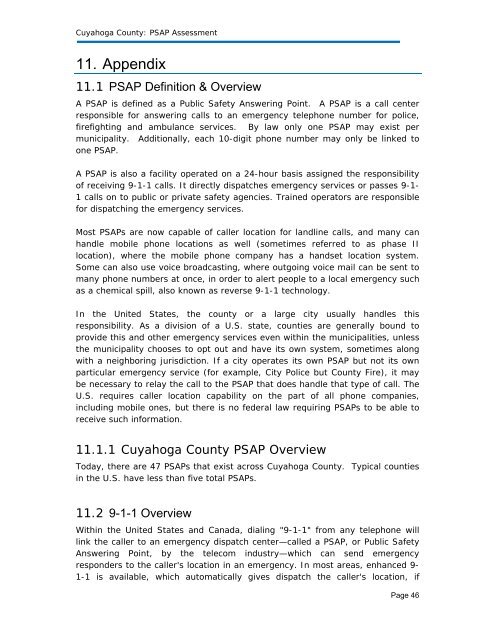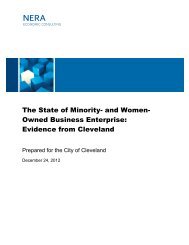Cuyahoga County: Public Safety Answering Point ... - Cleveland.com
Cuyahoga County: Public Safety Answering Point ... - Cleveland.com
Cuyahoga County: Public Safety Answering Point ... - Cleveland.com
Create successful ePaper yourself
Turn your PDF publications into a flip-book with our unique Google optimized e-Paper software.
<strong>Cuyahoga</strong> <strong>County</strong>: PSAP Assessment<br />
11. Appendix<br />
11.1 PSAP Definition & Overview<br />
A PSAP is defined as a <strong>Public</strong> <strong>Safety</strong> <strong>Answering</strong> <strong>Point</strong>. A PSAP is a call center<br />
responsible for answering calls to an emergency telephone number for police,<br />
firefighting and ambulance services. By law only one PSAP may exist per<br />
municipality. Additionally, each 10-digit phone number may only be linked to<br />
one PSAP.<br />
A PSAP is also a facility operated on a 24-hour basis assigned the responsibility<br />
of receiving 9-1-1 calls. It directly dispatches emergency services or passes 9-1-<br />
1 calls on to public or private safety agencies. Trained operators are responsible<br />
for dispatching the emergency services.<br />
Most PSAPs are now capable of caller location for landline calls, and many can<br />
handle mobile phone locations as well (sometimes referred to as phase II<br />
location), where the mobile phone <strong>com</strong>pany has a handset location system.<br />
Some can also use voice broadcasting, where outgoing voice mail can be sent to<br />
many phone numbers at once, in order to alert people to a local emergency such<br />
as a chemical spill, also known as reverse 9-1-1 technology.<br />
In the United States, the county or a large city usually handles this<br />
responsibility. As a division of a U.S. state, counties are generally bound to<br />
provide this and other emergency services even within the municipalities, unless<br />
the municipality chooses to opt out and have its own system, sometimes along<br />
with a neighboring jurisdiction. If a city operates its own PSAP but not its own<br />
particular emergency service (for example, City Police but <strong>County</strong> Fire), it may<br />
be necessary to relay the call to the PSAP that does handle that type of call. The<br />
U.S. requires caller location capability on the part of all phone <strong>com</strong>panies,<br />
including mobile ones, but there is no federal law requiring PSAPs to be able to<br />
receive such information.<br />
11.1.1 <strong>Cuyahoga</strong> <strong>County</strong> PSAP Overview<br />
Today, there are 47 PSAPs that exist across <strong>Cuyahoga</strong> <strong>County</strong>. Typical counties<br />
in the U.S. have less than five total PSAPs.<br />
11.2 9-1-1 Overview<br />
Within the United States and Canada, dialing "9-1-1" from any telephone will<br />
link the caller to an emergency dispatch center—called a PSAP, or <strong>Public</strong> <strong>Safety</strong><br />
<strong>Answering</strong> <strong>Point</strong>, by the tele<strong>com</strong> industry—which can send emergency<br />
responders to the caller's location in an emergency. In most areas, enhanced 9-<br />
1-1 is available, which automatically gives dispatch the caller's location, if<br />
Page 46
















